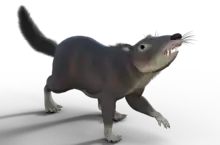Shuotherium
Shuotherium is a fossil mammal known from Middle-Late Jurassic of the Forest Marble Formation of England,[1] and the Shaximiao Formation of Sichuan, China.[2][3]
| Shuotherium | |
|---|---|
 | |
| Scientific classification | |
| Kingdom: | Animalia |
| Phylum: | Chordata |
| Class: | Mammalia |
| Family: | †Shuotheriidae |
| Genus: | †Shuotherium Chow & Rich, 1982 |
| Type species | |
| †Shuotherium dongi | |
| Species | |
| |
The original holotype is composed of a partial dentary and seven teeth (two which are incomplete).[2] The holotypes for other species of this genus are solely represented by isolated molars. Shuotherium, along with Pseudotribos has been placed in the family Shuotheriidae as a sister taxon of the Australosphenida (see, Yinotheria),[4] making it a relative of modern monotremes. However, some studies place it and other shuothereres as closer to therian mammals.[5][6]
Description
In the lower molars, the talonid is situated in front of the trigonid, such a unique dental form is distinct from the typical tribosphenic pattern. In this "pseudotribosphenic" trait, the mesial cingulid is expanded to form a pseudotalonid, and its distal talonid is underdeveloped. It shares with Australosphenida a thin, slender lower jaw but differs from the non-monotreme Ausktribosphenida by having more developed postdentary trough. Its dental formula has been reconstructed as: p4, m3 (four premolars, three molars).[4]
Kielan-Jaworowska, Cifelli & Luo 2002 had this to say regarding the fossil:[3]
In our view, the most compelling evidence as to the affinities of Shuotherium lies in the structure of the last premolar, which shares striking similarities to that of Australosphenida
Lower molar structure of Shuotherium and Australosphenida is obviously quite different, and for this reason we do not place Shuotherium within this Gondwanan clade. Based on the limited evidence available, however, we suggest that Shuotherium is a viable sister-taxon to Australosphenida.
Notes
- Sigogneau−Russell, D. 1998. Discovery of a Late Jurassic Chinese mammal in the upper Bathonian of England. Comptes Rendus de l’Académie des Sciences, Paris 327: 571–576
- M. Chow and T. H. V. Rich. 1982. Shuotherium dongi, n. gen. and sp., a therian with pseudo-tribosphenic molars from the Jurassic of Sichuan, China. Australian Mammalogy 54:127-142
- Kielan−Jaworowska, Z.; Cifelli, R.L.; Luo, Z.−X. (2002). "Dentition and relationships of the Jurassic mammal Shuotherium" (PDF). Acta Palaeontologica Polonica. 47 (3): 479–86
- Kielan-Jaworowska, Zofia; Cifelli, Richard L.; Luo, Zhe-Xi 2004. Mammals from the Age of Dinosaurs: Origins, Evolution, and Structure. New York: Columbia University Press. ISBN 9780231509275
- Rougier, Guillermo W.; Martinelli, Agustín G.; Forasiepi, Analía M.; Novacek, Michael J., New Jurassic mammals from Patagonia, Argentina : a reappraisal of australosphenidan morphology and interrelationships ; American Museum Novitates, no. 3566, 2007
- Tom Rich, Patricia Vickers Rich, Palaeobiogeography of Mesozoic Mammals – Revisited, Article · January 2012 DOI: 10.1007/978-90-481-3428-1_32
References
- Chow, M.; Rich, T. H. (1982). "Shuotherium dongi, n. gen. and sp., a therian with pseudo-tribosphenic molars from the Jurassic of Sichuan, China". Australian Mammalogy. 5: 127–42. Retrieved May 2013. Check date values in:
|accessdate=(help)CS1 maint: ref=harv (link) - Dykes, Trevor. "Mesozoic Mammals: Shuotheriidae & Australosphenida, an internet directory". Archived from the original on July 16, 2012. Retrieved May 2013. Check date values in:
|accessdate=(help) - Kielan−Jaworowska, Z.; Cifelli, R.L.; Luo, Z.−X. (2002). "Dentition and relationships of the Jurassic mammal Shuotherium" (PDF). Acta Palaeontologica Polonica. 47 (3): 479–86. Retrieved May 2013. Check date values in:
|accessdate=(help)CS1 maint: ref=harv (link) - Kielan-Jaworowska, Zofia; Cifelli, Richard L.; Luo, Zhe-Xi (2004). Mammals from the Age of Dinosaurs: Origins, Evolution, and Structure. New York: Columbia University Press. ISBN 9780231509275.CS1 maint: ref=harv (link)
- Sigogneau-Russell, Denise (1998). "Discovery of a Late Jurassic Chinese mammal in the Upper Bathonian of England". Comptes Rendus de l'Académie des Sciences, Série IIA. 327 (8): 571–576. doi:10.1016/S1251-8050(99)80040-8. OCLC 4931582858.CS1 maint: ref=harv (link)
- Wang, Yuanqing; Clemens, William A; Hu, Yaoming (1998). "A Probable Pseudo-Tribosphenic Upper Molar from the Late Jurassic of China and the Early Radiation of the Holotheria". Journal of Vertebrate Paleontology. 18 (4): 777–87. doi:10.1080/02724634.1998.10011106. JSTOR 4523955. OCLC 4899517409.CS1 maint: ref=harv (link)





